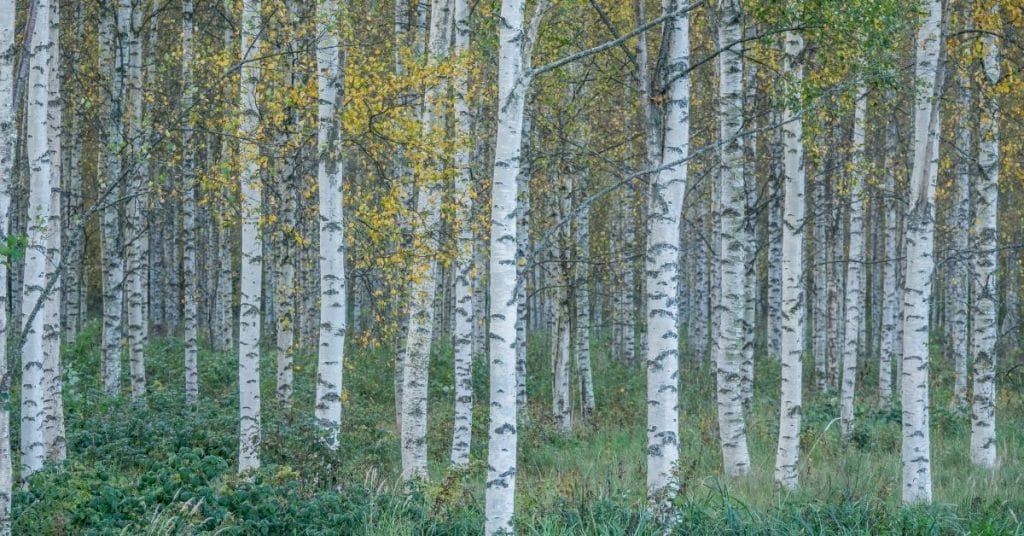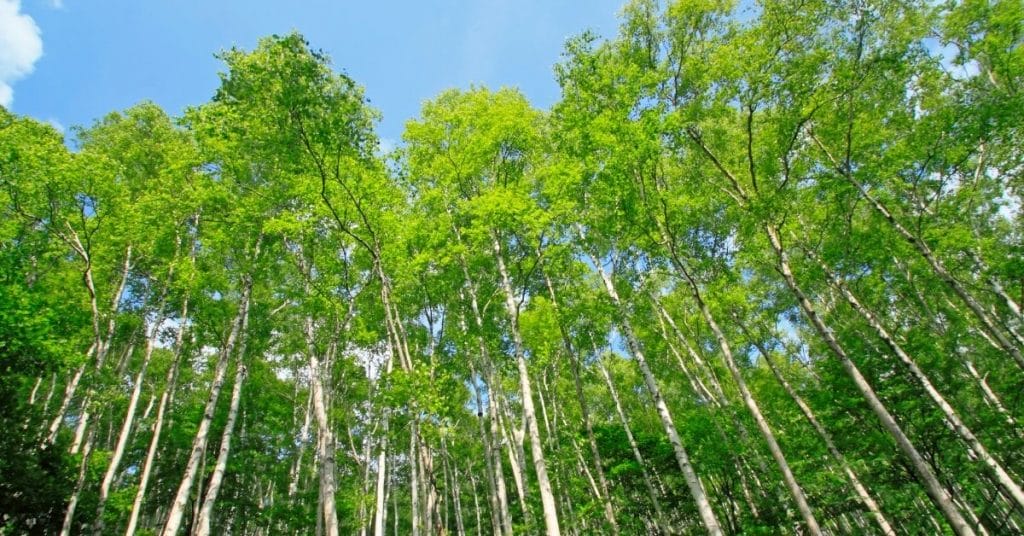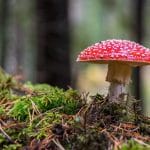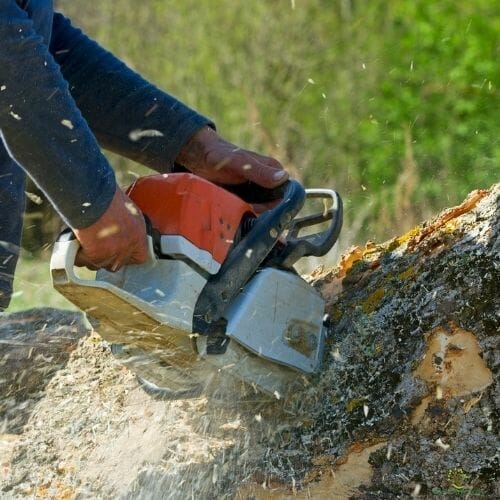How To Identify Birch Trees:
Species, Leaves, and Bark
Birch trees (genus Betula) are flowering deciduous trees with egg-shaped pointy leaves and thin papery bark. Birch trees turn a brilliant golden yellow, vivid orange, or flaming red in the fall. The bark of common birch trees comes in a variety of colours, including white, silver, black, grey, and yellow.
White birch, silver birch, and paper birch are all common birch varieties. Birch trees are commonly characterized by their bark, leaves, and blooms. Some birches, for example, have thin peeling bark that exfoliates in long strips, whilst others do not. Birch leaves can also be fashioned like an egg, a triangle, or a diamond.
This post will show you how to recognize common birch trees. Pictures and descriptions of birches can assist you in deciding which sort of decorative tree is appropriate for your yard. Read more here if you are interested in learning the difference between Aspen trees and Birch trees.
Birch Tree Facts
Birch trees are members of the beech-oak family Fagales and belong to the genus Betula. Birch trees are typically 40 to 70 feet (12–21 meters) tall, with canopies measuring 35 to 60 feet (10–18 meters). Dwarf birch trees are little trees that reach no more than 30 feet (9 meters) in height, with some reaching only 3 feet (1 meter).
There are 30 to 60 different species of birch (Betula), with 18 of them native to North America. Birch is a short-lived tree that grows well in the damp ground in cold, northern climes. USDA zones 2–7 are ideal for growing birch trees.
Slender, single stems with irregularly formed canopies are characteristic of several birch species. As the birch leaf grows higher up the tree, the white-grey, red, or black bark is revealed. Clumping birch trees with several trunks emerging from the ground are also common.
White birch trees can also be used as attractive trees in residential settings.
The density and sturdiness of birch wood are also valued. Skateboards, plywood, and loudspeaker cabinets are all made from birch trees. Birch is also good firewood since it burns well even when damp.

Birch Tree Leaves
Birch tree leaves have a rounded base, pointy tips, and serrated margins and are triangle or egg-shaped. The glossy green birch leaves are 2 to 3 inches (5 to 7.5 cm) long. On the branches, the simple leaves are placed alternately. Birch leaves turn brilliant hues of gold, red, and orange throughout the fall.
Between birch species, there are relatively modest changes in leaf morphology. White birch trees, for example, have more prominent teeth on their leaf margins. Grey birch leaves are triangular, whereas river birch leaves are diamond-shaped.
Birch Bark
Birch bark is typically whitish-grey, silver, or red. Most birch trees have horizontal dark lines in their bark that resemble scoring (called lenticels). Birch bark is also noted for its papery feel and tendency to peel. Birch trees have ornamental value in the winter because of their peeling bark.
Birch trees with white bark are the most commonly planted birch trees in gardens.
Birch Flower
Catkins are little, inconspicuous groups of flowering spikes on birch trees. Birch trees blossom in the springtime, about the same time that their leaves emerge. Male birch trees have flowers that are 1.2″ (3 cm) long, while female birch trees have flowers that are 0.4″ to 0.8″ (1 – 2 cm) long.

How To Identify Birch Tree
Birch tree species can be distinguished by their bark and leaf form. Birch trees are identified by their peeling bark, which can be white, grey, or yellow. On the light-coloured bark, you’ll also observe horizontal diamond-shaped raised markings. Examine the leaves: birch leaves are often triangular with jagged edges.
How To Distinct Birch Trees vs. Aspen Trees
Birch trees can easily be confused with aspen trees. With their slender white or grey trunks, birch trees and aspens appear identical from a distance. Close inspection reveals that birches have peeling bark, whereas aspen trees have rough, fissured bark.
Birch trees and aspen trees can also be distinguished by their leaves. Birch leaves are usually triangular or pear-shaped, with serrated edges. The leaves of the aspen tree are more heart-shaped and have finely serrated edges. Birch leaves are also elongated and have a “V” form, unlike flat aspen leaves.
Birch Trees In The Fall
Birch trees are deciduous trees that offer a beautiful fall decorative charm. In the fall, the leaves of birch trees change colour from a lustrous green to brilliant colours of gold. The colours of birch trees in the fall range from golden yellow to warm autumn colours of orange, bronze, and red. The bark of certain birch trees turns golden, much like the leaves.

Types of Birch Trees
Let’s take a closer look at the various species of birch trees that may be found in forests, parks, and gardens.
White Birch Tree (Betula Pubescens)
The white birch tree has fluffy ovate leaves and white, papery peeling bark. White birch trees can reach heights of 30 to 65 feet (10–20 meters). The tree’s columnar look is due to its slender white trunk with upright limbs. The fall hues of white birches are a warm yellow.
The white birch is a European tree. The white birch tree is also known as ‘downy birch,’ ‘hairy birch,’ and moor birch.’ The silver birch and the white birch are commonly confused (Betula pendula). It does, however, have silky downy branches.
White birch leaves have severely serrated margins compared to other birch species.
The white birch is a cold-hardy broadleaf tree that can be found in USDA zones 2 through 9. The tree grows best in full sun with lush, damp soil.
The leaves of a white birch tree are simple and placed alternately. The triangular leaves have a tapering tip and a rounded base. Look for irregularly serrated borders as well. White birch leaves range in length from 1.2″ to 2.4″ (3–6 cm) and width from 2″ to 5 cm.
White birch tree bark: Gently cleanses in papery strips, leaving a dull white bark.
Weeping Silver Birch Tree (Betula Pendula)
Pendulous branches on the silver birch give the tree a weeping aspect. The shiny green leaves of the weeping silver birch turn a beautiful yellow colour in the fall. The leaves have a double-toothed edge and are oval. The bark is silvery-white with contrasting horizontal black stripes, as its name suggests.
Weeping silver birch plants thrive as shade trees in large gardens. As a landscape tree, its arching canopy, oval shape, and slender silvery trunk are magnificent.
Silver birch trees can be planted in USDA zones 2 through 7. Full to partial light and well-draining soil is ideal for deciduous trees.
The ‘lady of the woods,’ ‘weeping birch,’ European white birch,’ ‘warty birch,’ and ‘lady birch,’ are all names for the weeping silver birch.’
Shiny green leaves are 2.5″ (7 cm) long and have a unique triangular shape with jaggy-looking margins on silver birch trees. Warm yellows dominate the fall colours of silver birch.
Silver birch tree bark: Young growth has a golden brown bark that fades to silvery white with black areas as it matures.
Paper Birch Tree (Betula Papyrifera)
The paper birch, also known as the white birch, takes its name from its thin, white papery bark. Because of its golden fall colour and thin, peeling, smooth pure white bark, the paper birch tree has ornamental appeal in garden landscapes. The leaves have unevenly serrated margins and are egg-shaped.
Paper birch trees can be grown as single stem trees or multi-stemmed trees. Paper birch trees often reach a height of 50 to 70 feet (15–21 meters) and have a rounded crown. Paper birch trees with several stems do not grow as tall.
USDA zones 2 through 7 are ideal for growing paper birch trees. Ornamental paper birch trees can live up to 100 years in cold areas. They don’t survive as long in hotter climates.
Canoes were made from the paper birch tree. This is why the tree is also known as the canoe birch. The white birch gets its name from its dazzling white bark.
Paper birch tree leaves: Leaves have an ovate form and uneven serration on the margins. The 4″ (10 cm) long leaf blades transition from dark green to bright yellow in the fall.
Paper birch tree bark: Shiny white bark peels away in strips to reveal orangey-brown bark beneath.
Yellow Birch Tree (Betula Alleghaniensis)
The yellow birch tree is a medium-sized tree with elongated oval, glossy green leaves with coarsely serrated margins and vivid yellow fall colours. The leaves of this slender deciduous tree grow in a conical shape. The tree’s bark begins as a gleaming bronze before becoming shaggy, papery, and grey-brown.
Yellow birch trees can reach heights of 50 to 80 feet (15 to 24 meters). The lovely bark, huge pointed leaves, and rich fall hues of yellow birches provide year-round seasonal interest.
Swamp birch, grey birch, hard birch, and silver birch are some of the other nicknames for the yellow birch tree.
Yellow birch tree leaves: The borders are unevenly serrated and the form is lanceolate. In the fall, the dark green birch leaves turn a dazzling golden colour with traces of lime green. The long birch leaves range in length from 3″ to 5″ (7–12 cm).
Yellow birch tree bark: When young, the bark is polished brown, but as it ages, it becomes silvery-grey. Peeling in short strips, the bark has a yellow-bronze hue.
River Birch Tree (Betula Nigra)
River birch trees have a pyramidal crown, reddish-brown exfoliating bark, glossy green diamond-shaped leaves, and a reddish-brown exfoliating bark. Because of the hooked tips, this fast-growing river birch tree features silky fuzzy twigs and unusual buds among trees. River birch leaves turn a golden yellow color in the fall.
It can reach a height of 80 to 100 feet (25 to 30 meters) and has several slender trunks. The clumping river birch grows well in damp soil as a beautiful tree in garden landscapes.
The river birch is the ideal birch tree to plant in warm climates. The most heat-tolerant of all the species are river birches. River birch thrives throughout the northern United States, as well as Florida and Texas. USDA zones 4 through 9 are suitable for this birch species.
The river birch is also known as the ‘black birch,’ ‘water birch,’ or ‘clump river birch.’
River birch tree leaves Leaves are diamond-shaped and have double-serrated edges. The upper side of birch leaves is glossy green, while the underside is yellowish-green. The leaves turn a brilliant yellow color in the fall.
River birch tree bark: The tree trunk has flaky bark that peels and twists. The bark is initially pink, smooth, and lustrous. The bark of the birch tree turns reddish-brown and peels off, revealing orangish flakes of bark.
Gray Birch Tree (Betula Populifolia)
The grey birch is a slender, fast-growing deciduous tree with many trunks. Grey birch leaves have an extended tip and are triangular in shape. The upper side of the ovate leaves is glossy green, while the underside is pale. The bark of the grey birch is a pale grey, nearly white color with black patches.
Grey birch trees are medium-sized trees that reach a height of 20 to 30 feet (6 to 10 meters).
Grey birch trees get their scientific name from their leaves, which resemble those of poplar trees.
Grey birch trees might resemble paper birch trees in appearance. Look at the bark and leaves of the trees to tell them distinct. The leaves of grey birch trees have more pointed points than those of paper birch trees, and the bark does not flake.
Grey birch tree leaves Leaves are triangular in shape and taper to a long tip. Grey birch trees can be identified by their double-toothed edges and lustrous upper leaves. The fall color is an unremarkable yellow.
Grey birch tree bark: The bark has a chalky whitish-grey color and does not peel.

Sweet Birch Tree (Betula Lenta)
A deciduous tree with huge, ovate-shaped leaves with beautifully serrated margins, the sweet birch is a deciduous tree. Sweet birch trees have among of the largest leaves in the genus, with leaves up to 6″ (15 cm) long. Pendulous flowers appear before the leaves in the spring.
The aroma of wintergreen in the twigs, bark, and leaves gives the sweet birch tree its name. The other common names refer to the tree’s various characteristics. For example, because of its dark bark, the birch is known as the ‘black birch.’ Because of the color of the bark of mature birch trees, they are called ‘cherry birch’ and mahogany birch.’ Due to the distinctive wintergreen perfume it exudes, it’s also known as spice birch.’
Sweet birch trees can reach a height of 100 feet (30 meters). However, these birch trees often reach a height of 50 to 80 feet (15 to 24 meters) in residential landscaping.
Sweet birch tree leaves: The glossy leaves begin as a light green color before darkening and developing a rich golden yellow color in the fall. Leaves range in size from 2″ to 6″ (5–15 cm). When smashed, these birch leaves emit a lovely scent.
Sweet birch tree bark: The bark of younger sweet birch trees is smooth, gray, and has short horizontal lenticels. Older birch trees grow hard, severely fissured bark with uneven scaly plates, unlike other birch trees.
Dwarf Birch Tree (Betula Nana)
The dwarf birch tree is a big shrub rather than a tree. This shrubby plant has spherical leaves with bluntly serrated edges and grows to be about 3 feet (1 meter) tall. The leaves are bright green and turn scarlet in the autumn. Dwarf birch trees grow in USDA zones 1 through 8 and are well-suited to arctic climates.
Other names for the dwarf birch tree are bog birch and arctic birch.
The dwarf birch (Betula glandulosa) in the United States is similar. The only difference is that the leaf blades are joined to the twigs by longer petioles.
Himalayan Birch Tree (Betula Utilise)
The Himalayan birch tree has a papery bark, egg-shaped leaves that are slightly fuzzy, and small conical blooms. The Himalayan birch, like most birches, has peeling bark that is white, reddish-brown, or reddish-white. The bark peels away in small sheets, exposing the pinkish bark beneath. The shiny green birch leaves range in size from 2″ to 4″ (5–10 cm).
The Himalayan birch tree can grow up to 66 feet (20 meters) tall as a big shrub or tree. The single trunk branches closer to the ground, forming a vase-shaped canopy of green foliage with white bark.
Japanese White Birch (Betula Platyphylla)
It has grayish-white bark, spreading branches, and yellowish-green triangular leaflets with tapering tips, and is sometimes known as the ‘Asian white birch.’ The serrated margins of the 3-inch (7.5-cm) leaves cover branches to form a pyramidal crown.
Zones 4–7 are ideal for the Japanese white birch. The ornamental birch tree grows between 30 and 40 feet (10 – 12 meters) tall and 15 to 25 feet (4.5 – 7.6 meters) broad in cooler climes.
Contact us at West Austin Tree services, or search for tree services in your area here.

















